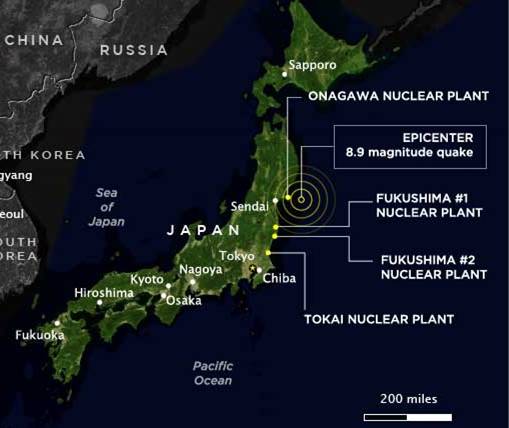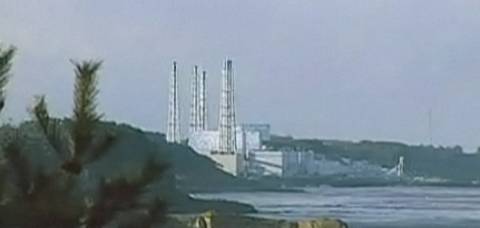Major US news agencies reporting a hydrogen explosion at Fukushima Dai-ichi No. 2 may have breached the containment vessel. Tepco, the Japanese company that owns this plant has evacuated operators from the area. There are reports of elevated radiation levels in the area near the plant.
This plant just had its license extended in February. South Texas Plant (STP) is in the process of extending its license for its 22 year old units 1 and 2.
Check national news sources for breaking news.
Posted in Nuclear | Tagged nuclear japan tepco, public citizen texas, Texas |
Robert Singleton, an anti-nuclear activist and writer, is calling for a moratorium on new nuclear reactors, license extensions. Robert is a member of Solar Si Nuclear No in Austin, Texas. Click here to read Robert’s blog.
As of today, several countries have announced intentions to review their nuclear power policies as a result of the unfolding drama in Japan.
- India announced a review of all nuclear reactors in the country in view of the Japanese radiation leak. India has 20 nuclear power plants, mostly located along the coast.
- Germany’s coalition government has suspended an agreement prolonging the life of the nation’s nuclear power stations, Chancellor Angela Merkel said.
- The Swiss government suspended plans to replace and build new nuclear plants pending a review of the two hydrogen explosions at Japanese plants.
Posted in Nuclear | Tagged japanese nuclear disaster, moratorium, nuclear energy, public citizen texas, Texas |
The word “meltdown” goes to the heart of the big nuclear question – is nuclear power safe? Richard Black, Environment correspondent with the BBC News tries to answer this question and address questions about what is happening at the Fukushima Daiichi plant. Click here to read the BBC article.
One issue he does bring up is that Fukushima Daiichi is bound to raise some very big questions, inside and outside Japan including here in Texas.
Last year Nuclear Innovation North America LLC (NINA), the nuclear development company jointly owned by NRG Energy, Inc. (NYSE:NRG) and Toshiba Corporation, announced they had reached an agreement with Tokyo Electric Power Company (Tepco), that owns the Fukushima Daiichi, to partner in the two new nuclear units at the South Texas Project (STP).
Tepco has been implicated in a series of cover-ups down the years.
- In 2002, the chairman and four other executives resigned, suspected of having falsified safety records at Tepco power stations.
- Further examples of falsification were identified in 2006 and 2007.
As Austin Energy and CPS consider the Power Purchase Agreements NRG is peddling they should look very hard at what is happening in Japan and at TEPCO’s ability to remain a financial partner in STP.
In a Wall Street Journal article by Rebecca Smith (click here to read the entire article), she writes that the unfolding crisis at the Fukushima Daiichi nuclear power plant casts doubt on the fundamental premise that has undergirded the global nuclear industry for five decades: that engineers can build enough redundancy into plant safety systems to overcome dangers.
Peter Bradford, a member of the Nuclear Regulatory Commission at the time of the Three Mile Island accident in Pennsylvania in 1979 (who has spoken to local leaders in Central Texas about numerous issues that should preclude them from becoming partners in or signing power purchase agreements with NRG in the STP expansion), said that the accident exposes shortcomings in risk analysis as well as in engineering.
“The redundancy, such as it was, obviously was inadequate to the event that actually happened,” he said. He said the problem is that certain risks always are discounted in the licensing process as “so highly unlikely that you don’t have to plan for them.”
He said that may be the case in Japan, with an earthquake that apparently exceeded the level that the plant was designed to withstand, possibly compounded by other unexpected technical problems or by the tsunami. It’s not yet known if operator error may have played a role, as it did three decades ago at Three Mile Island.
“The really important question,” Mr. Bradford said, “is to ask how different licensing bodies decide what risks have to be guarded against and see if that analysis was adequate.”
Even Texas Congressman Joe Barton, who is chair emeritus of the House Committee on Energy and Commerce and a strong proponent of the push for nuclear expansion in the U.S. is now saying:
. . . that nuclear plants are designed with earthquakes in mind. “They’re supposed to be double and triple redundant…. If I’ve been to one briefing, I’ve been to a dozen, given by the industry, where they talk about all the safety features and the built-in redundancy features that protect the reactors in the event of an accident, a natural disaster, even a terrorist attack.”
Mr. Barton added that he’s “very puzzled that, even as big as this earthquake was, the plant didn’t meet those standards. That’s something that even proponents of nuclear power want to get to the bottom of…. I believe very strongly in the future of nuclear power, but those who support it have to insist that the safety redundancy features perform.”
To date, the major stumbling block to the US rushing headlong into a “nuclear renaissance” has been the huge financial cost and risks involved in building new nuclear plants in down economy. It is tragic and unfortunate that it is taking the failure of these Japanese plants in the wake of what surely is one of the worst disasters in Japanese history to cause the US to look more closely at their rush to increase our country’s nuclear portfolio.
Posted in Nuclear | Tagged Fukushima Daiichi, Nuclear, public citizen texas, STP, TEPCO, Texas |
According to an update from the Nuclear Information and Resource Service (NIRS) an explosion has occurred at Fukushima Daiichi Unit 1.
[youtube=http://www.youtube.com/watch?v=jMEV-_X5b_8]
Video of the aftermath of the explosion shows that the containment building
has been destroyed.
[youtube=http://www.youtube.com/watch?v=ELR3hdlce2g]
The NIRS update goes on to explain, in a General Electric Mark I reactor, the containment building is fairly weak and is considered the secondary containment. The primary containment is a steel liner that surrounds the reactor core. So far, video and photos have not been clear enough for us to determine whether this steel liner is intact.
Radiation levels at the site are reported to be 1,015 micro/Sieverts per hour. This is roughly equivalent to 100 millirems/hour. The allowable annual dose for members of the public from nuclear facilities in the U.S. is 100 millirems/year. The allowable annual dose for nuclear workers is 5,000 millirems/year. The average annual background dose from all radiation sources in the U.S. is about 360 millirems/year.
The explosion in Unit 1 was almost surely a hydrogen explosion. Pressure has been building up in the containment since offsite power was lost to the reactor because of the earthquake/tsunami. The GE Mark I reactor design is called a “pressure suppression” design. Rather than be built to withstand large pressure increases, General Electric sought with this design to attempt to reduce such increases in an accident scenario. The design has been criticized by independent nuclear experts and even Nuclear Regulatory Commission staff for many years (see: http://www.nirs.org/factsheets/bwrfact.htm). In this case, the design clearly did not work. 24 U.S. reactors use the GE Mark I design.
The evacuation zone around the site has been expanded to 20 kilometers (about 12 miles). Another reactor at Fukushima Daiichi, Unit 2, is reported to be without cooling capability at this time. Three reactors at the nearby Fukushima Daini site are reported to be without cooling capability. These are GE Mark II designs, which are considered a mild improvement over the Mark I design. Both sites are on the Pacific Ocean, about six miles apart.
Posted in Global Warming | Tagged Containment building, explosion, Nuclear Power, Nuclear reactor core, Nuclear Regulatory Commission, public citizen texas, Texas |
The Public Utility Commission (PUC) sunset bill (H.B. 2134) would give the PUC the authority to approve or change the annual budget of the Electric Reliability Council of Texas (ERCOT), stipulates that no member of the PUC could work for ERCOT for at least two years after he or she had stepped down, and fines would quadruple (from a maximum of $25,000 per day to $100,000 per day) for any company found to have manipulated the electric market for its own gain under the Sunset bill that will be heard in House State Affairs Committee on Monday, March 14th.
State Rep. Burt Solomons’ House Bill 2134 largely tracks the recommendations approved in January by the Sunset Advisory Commission and includes language that the Carrollton Republican has been advocating for at least two years to cut the number of ERCOT board members who have ties the electric industry.
State Affairs is scheduled to take up the Sunset bill during its hearing that convenes 30 minutes after the House adjourns Monday. The meeting will be held in Room 140 of the Reagan Building northwest of the Capitol.
To see the full text of H.B. 2134, click here.
Posted in Energy, Sunset, Texas Legislature | Tagged electric reliability council of texas, Electricity market, Energy, Public utilities commission, Sunset Advisory Commission, Texas |
This morning’s quake on the other side of the world has implications for nuclear plants here in the U.S. The Nuclear Regulatory Commission (NRC), through its regional office in Arlington, TX, announced they are closely monitoring this situation – the Japanese earthquake and subsequent tsunami – as it unfolds with respect to nuclear facilities within the United States.
Earlier today the NRC issued a “notice of unusual event” (NOUE) at the Diablo Canyon Power Plant, located near San Luis Obispo, CA. In addition to the Diablo Canyon plant, the NRC is also monitoring the San Onofre nuclear power plant, the Humboldt Bay spent fuel storage site and NRC-regulated nuclear materials sites in Hawaii and Alaska to name a few.
A push to build new nuclear facililties in the U.S. has catapulted the nation’s aging nuclear industry into the limelight and the NRC is being quick to assure the public that nuclear power plants are engineered to withstand environmental hazards, including earthquakes, tsunamis and other natural disasters.
The NRC claims plants are designed to take into account the most severe natural phenomena historically reported for the site and surrounding area. Still, while the emergency situation at two Japanese plants is seemingly contained at this point, with one Texas plant situated on the hurricane prone Texas Gulf coast and the other in the middle of tornado alley, one has to wonder . . . what if we haven’t yet seen the most severe natural phenomena for those areas?
Posted in Nuclear | Tagged japan, Nuclear Power, Nuclear Regulatory Commission, Texas |
Japan’s nuclear safety agency said workers are currently scrambling to restore cooling water supply at the facility, but that there was no prospect for an immediate success. So far there have been no reports of any radiation leaks.
UPDATE: At 4:30 CT on Friday, March 11th all the U.S. news outlets were breaking news about radiation levels in the control room of the No. 1 reactor of the Fukushima nuclear power plant reaching around 1,000 times the normal level and that some radiation has also seeped outside the plant, prompting calls for further evacuations of the area.

Japan's nuclear plants near the earthquake epicenter from MSNBC (http://www.msnbc.msn.com/id/42025882/ns/world_news-asiapacific/)
The quake struck just under 250 miles northeast of Tokyo, the U.S. Geological Survey said. It was followed by more than a dozen aftershocks, one as strong as 7.1, and eleven nuclear reactors were automatically shut down in the affected area, according to the Japanese government, but they haven’t confirmed any effects induced by radioactive materials outside the facilities.
In addition to the situation at the Fukushima plant, at the TEPCO’s nearby Onagawa facility, which is in the worst-hit Miyagi prefecture north of the Fukushima facility, a fire broke out at the plant following the quake. The blaze occurred in a turbine building, which is separate from the plant’s reactor, and was reported as being quickly extinguished. However, there seems to be some concerns about the cooling system at this plant too and the the Japanese government has also declared a state of emergency at this facility. Another unit at Onagawa is reported as experiencing a water leak, though it is unclear whether the incident is significant.
Obviously, we don’t know if any of these reports will lead to a serious nuclear event or not, but the isolated reports so far are worrisome.
In this region, earthquakes are a design basis accident which nuclear plants are supposed to survive, but engineering, while it can take many factors into consideration and build in multiple backups, can only be tested by an actual natural disaster. The problem is, under such circumstances, if there is a failure, one can only assume that other systems (transportation, power availability, access to experts and technicians – all the ancillary things ones needs to deal with a containing a serious event) will also be disrupted. So when a nuclear “expert” tell you that a plant is designed to withstand a massive hurricane, storm surge, tornado, or earthquake, keep that in mind.
Related Articles
- Japan declares ‘nuclear emergency’ after quake (guardian.co.uk)
- Evacuation ordered after Japan nuke plant rocked (msnbc.msn.com)
- Fire in Japanese Onagawa nuclear plant (reuters.com)
Posted in Global Warming, Nuclear | Tagged earthquake, japan, natural disasters, Nuclear Power, Texas |
San Antonio, which sits just north of what many say is one of the largest oil and gas reserves in the country known as the Eagle Ford, is a heart beat away from violating federal air quality standards for ground-level ozone. It seems it is only a matter of time before the increased emissions from the Eagle Ford could drift up on prevailing winds, pushing the area out of compliance.
With drilling expected to increase over the next decade, those responsible for this region’s air quality say the increased pollution could make it difficult to remain under federal limits. In the past decade, San Antonio’s ozone levels have decreased by 13 percent while its population has increased 13 percent, managing to stay just ahead of federal standards. However, once a region falls out of compliance, efforts to get back in are time-consuming, politically unpopular and expensive.
It is going to be a tough contest for the environment to compete with the hype about the economic benefits (which always fail to take into account the economic costs to the region for these types of activities – increased health care costs, decreased quality of life costs, and the cost of coming back into compliance with federal air quality standards).
According to a study by the Center for Business Research at the University of Texas at San Antonio and commissioned by America’s Natural Gas Association:
Activity in the Eagle Ford in 2010 alone generated more than $2.9 billion in total revenue, supported roughly 12,600 full-time jobs and provided nearly $47.6 million in local government revenue.
Last year there were 72 active oil leases, some of which may have more than one well, and 158 producing gas wells.
However, the number of drilling permits issued by the Texas Railroad Commission, which regulates the state’s oil and gas industry, has reached 1,132 as of February. In just one year, the output of crude oil, condensate and other liquids nearly quadrupled to 3.9 million barrels.
And the boom has just begun; the UTSA study forecasts that 5,000 more wells could be drilled by 2020.
So far, no regulatory agency has begun comprehensive air monitoring in the Eagle Ford area, meaning there’s no baseline to measure any increased pollution.
Models for other regions of the country show drilling and related emissions can increase ground-level ozone significantly and the sheer volume of drilling that’s expected over the next decade, will require Alamo Area Council of Governments (AACOG) to add a new category, for drilling and recovery, into its air pollution forecasting models.
The San Antonio Express News writes about the area:
The Eagle Ford shale covers a swath roughly 50 miles wide and 400 miles long, from Maverick and Webb counties sweeping north and east up to Leon and Houston counties, but not including Bexar County. Unlike other large shale formations that have recently been tapped, the Eagle Ford includes a good deal of oil, mostly along the northern reach.
Because oil prices are high and natural gas prices low at the moment, there’s more activity in the oil region at this time, industry analysts say.
Drilling has occurred in South Texas for decades, but the oil and gas trapped in the deeper, dense rock layers once were too expensive to reach. Advances in drilling technology, most notably hydraulic fracturing and horizontal drilling, have allowed an unprecedented amount of hydrocarbons to be extracted.
“Fracking,” as it’s known, forces millions of gallons of water, mixed with sand and a variety of chemicals, into shale formations, forcing open fissures to allow the natural gas and oil to escape. Horizontal drilling allows for one hole to be drilled vertically, then one or more pipes to branch out into the shale.
Together, these techniques have spawned a natural gas boom in the country, with some industry experts estimating a 100-year supply of a fuel that burns more cleanly than coal and could help push the country toward energy independence.
In other parts of the country the boom is well under way, and as drilling has increased, so have complaints about its environmental impacts, most notably drinking water contamination. While it remains unclear whether fracturing has contaminated drinking water, the EPA last month agreed to study the entire life cycle of the gas production process, to determine how it can affect drinking water supplies.
While water has gotten the lion’s share of the attention thus far, air quality concerns also are increasing and seem to be the area of most concern to San Antonio as they look toward increased drilling activities in the region. Let’s hope they can stay ahead of this new boom.
Related Articles
- Fracking Has Added Another Problem (fool.com)
Posted in Air Quality, natural gas | Tagged Alamo Area Council of Governments, Eagle Ford Formation, hydraulic fracturing, natural gas, San Antonio, Texas |
The long-awaited Sunset Bill of the Railroad Commission was released late yesterday, and it’s mostly what we’d expected, but not everything we’d hoped for.
Highlights:
- The Railroad Commission will be renamed the Texas Oil and Gas Commission
- It will be headed by one commissioner (down from 3) who will be elected every four years on the same cycle as Governor, Comptrollerm, Ag Commissioner, etc.
- Campaign finance reform: Commissioners and candidates for the commission can only raise money one year before an election and 30 days after.
- Moving contested hearings to the State Office of Administrative Hearings (SOAH).
These are needed reforms and the problems they attempt to correct are huge. For instance, the large influence campaign money has in the election of the Railroad Commission historically, as detailed in our report Drilling for Dollars. Among our findings was that nearly half of all campaign donations were being solicited and received in non-election years. Creating this fund-raising window will help keep at least the appearance of impropriety away from the new Oil and Gas Commissioner for at least 3 out of every 4 years, though we’re fairly certain the money will gush in all the same. This is why we proposed public financing for this important new office, but barring that, at least better disclosure of who is giving the money (specifically the occupation and employer of donors) and putting a cap on how much someone can give.
Unfortunately, this bill also does not offer any new guidance on regulation of fracking and natural gas drilling. Currently fracking regulation is in somewhat of a no man’s land, as Railroad Commission says they do not enforce our environmental laws, but TCEQ says they don’t regulate the operations of drillers. While it’s possible some of these reforms will come from the TCEQ sunset or from separate legislation, the bottom line is that we cannot allow our agencies to play hot potato with this issue.
So, what does this mean that we would get one new oil and gas commissioner from three current railroad commissioners? If passed in its current form, the railroad commission would be abolished- the railroad commissioners would be out of a job. Not a big deal for those like Michael Williams, who has said he will resign next month in order to pursue a run for Senate. Elizabeth Ames Jones has hinted she would do the same. Upon creation of the new Oil and Gas Commission, the first commissioner would be appointed by Governor Perry, but s/he would only serve until 2012, when the first Oil and Gas Commissioner race in the history of Texas would take place. Whoever wins that race would serve for only two years, then be up for re-election in 2014, and then elections would take place every four years after that.
This is many steps forward from where we began, and we’re grateful that both the Sunset Commission staff and Committee members listened to our (the environmental and good government community’s) thoughtful proposals and adopted some of them into this reform package. It’s a testament to the power of people showing up and making their voices heard. But this is the beginning, not the end. So in the spirit of making our voices heard, please remember to join us Tuesday for ACT Lobby Day. This will be an opportunity for you and us to ask for even more needed reforms both at RRC and TCEQ.
###
By promoting cleaner energy, cleaner government, and cleaner air for all Texans, we hope to provide for a healthy place to live and prosper. We are Public Citizen Texas.
Posted in Sunset | Tagged hydraulic fracturing, Oil and Gas Commission, Texas, Texas Railroad Commission |
Senator Glenn Hegar (R-Katy) filed a bill (SB 655) to abolish the Texas Railroad Commission and eliminate the three statewide elected positions that govern it and rename the agency the Texas Oil and Gas Commission to be run by a single elected officer who would serve a four-year term.
The bill has been referred to the Senate Government Organization Committee.
The Railroad Commission, a 121-year-old agency whose mission has changed dramatically over its lifespan, and which many have said has grown unwieldly and ineffective, has three elected commissioners who, with their separate staffs, often stumble over one another. Still, whether a single commissioner would be preferable to three is likely to be the most contentious piece of energy-related Sunset legislation that lawmakers take up this session and even the three sitting commissioners are split on how the agency should be structured.
Hegar’s bill also contains language that would have the newly restructured agency adopt the model of the State Office of Hearing Examiners (SOAH) on rulemaking dispute-resolution matters. It also calls for establishing a $20 million oilfield cleanup fund to be financed by fees from various industry activities.
To see the Railroad Commission Sunset bill, click here.
Meanwhile, Senator Joan Huffman (R-Southside Place/Houston) co-filed the Sunset bill (SB 657) to reauthorize the Texas Commission on Environmental Quality with Senator Glenn Hegar (R-Katy). A companion bill was filed in the house (HB 2694) by Representative Wayne Smith (R-Baytown).
All of these legislators are from areas of Texas whose air quality is highly impacted by the decisions of the TCEQ and dominated by the oil and gas industry.
To see the TCEQ bill SB 657, click here. If you also want to follow the House companion bill HB 2694, click here.
Senator Robert Nichols (R-Jacksonville) said he plans to introduce the legislation affecting the Public Utility Commission and related agencies before the bill-filing deadline.
Posted in Air Quality, Sunset, TCEQ | Tagged Public utilities commission, Texas, Texas Commission on Environmental Quality, Texas Railroad Commission, Texas sunset |
 The House Business and Industry Committee will meet next Monday and one of the bills that they will be taking testimony on is HB 450 filed by Representative Eddie Lucio, III (D-San Benito) that addresses the regulation of solar energy devices by a property owners’ association. If you are a homeowner who wants solar but your HOA rules prohibit the installation of solar panels, and you live in the district of one of the committee members, you might want to call your representative and let them know that you support this bill.
The House Business and Industry Committee will meet next Monday and one of the bills that they will be taking testimony on is HB 450 filed by Representative Eddie Lucio, III (D-San Benito) that addresses the regulation of solar energy devices by a property owners’ association. If you are a homeowner who wants solar but your HOA rules prohibit the installation of solar panels, and you live in the district of one of the committee members, you might want to call your representative and let them know that you support this bill.
Feeling really passionate about this and plan on being in Austin next Monday – stop by the capitol after 2pm, go to the hearing room-E2.016 and sign up to testify for this bill.
Below is a list of the House Business and Industry committee members and their capitol office phone numbers.
Posted in Renewables | Tagged Energy, HB 450, renewable, solar, solar energy, Texas, Texas House Business and Industry Committee |
The Atomic Safety and Licensing Board (ASLB) will hear oral argument relating to the Victoria County Station Early Site Permit (ESP) proceeding on March 16-17 in Victoria, Texas.
The ASLB is the independent body within the NRC that presides over hearings where the public can challenge proposed licensing and enforcement actions.
Oral arguments will begin at 9 a.m. CDT on Wednesday, March 16, in the Theatre Victoria at the Leo J. Welder Center for the Performing Arts, 214 N. Main St. in Victoria. The session will continue at 9 a.m. CDT on March 17. The session is open for public observation, but participation will be limited to authorized representatives of the groups taking part in the proceeding (Texans for a Sound Energy Policy [TSEP], the applicant – Exelon Nuclear Texas Holdings – and NRC staff involved in the proceeding).
Early arrival is suggested to allow for security screening for all members of the public interested in attending. NRC policy prohibits signs, banners, posters or displays in the hearing room.
Exelon submitted an ESP application March 25, 2010, seeking approval of the Victoria County Station site, which is approximately 13 miles south of Victoria. The ASLB is considering whether to grant TSEP intervenor status. The group has submitted several objections, or contentions, challenging Exelon’s application. The ASLB will hear oral argument on whether TSEP’s contentions meet the NRC’s requirements to be admitted for hearing under the NRC’s jurisdiction.
Documents related to the Victoria County Station ESP application are available on the NRC Web site at: http://www.nrc.gov/reactors/new-reactors/esp/victoria.html .
Documents pertaining to the ASLB proceeding are available in the agency’s electronic hearing docket at: http://ehd1.nrc.gov/EHD .
More information about the ASLB can be found at: http://www.nrc.gov/about-nrc/organization/aslbpfuncdesc.html.
Posted in Global Warming | Tagged Exelon, Nuclear Regulatory Commission, public citizen texas, Texas, Victoria Texas |
 Repower America, wants to share an important piece of news with you.
Repower America, wants to share an important piece of news with you.
The U.S. Environmental Protection Agency (EPA) is planning to limit global warming pollution from big fossil fuel industries like power plants and petroleum refineries. These industries alone account for about 40% of the global warming pollution in the U.S. — making them the two largest sources of emissions.
Here’s where you come in. The EPA is charged with developing rules called New Source Performance Standards (NSPS) that will protect public health, reduce the pollution that causes climate change, and send a signal to polluters that they need to invest in clean energy technologies.
It’s crucial that the EPA sticks to its schedule and develops strong rules. Between now and March 18, the EPA is accepting comments on their plans. They will definitely be receiving comments from the coal, gas and oil industries. Make sure they hear from you, too.
These rules are common sense. The EPA was created to understand our impact on our environment and protect the health of our people. An overwhelming majority of scientists are united in their understanding of the effects of global warming pollution and the EPA is charged with developing rules based on that science. Yet strong special interest groups are working to derail that process.
The EPA needs to hear that you support their efforts to limit global warming pollution from these industries. That’s why you need to encourage the EPA to issue strong New Source Performance Standards without delay.
The science is clear: Climate change is happening. Unfortunately, big polluters will make big profits if they mislead the American public about that fact. RePower America needs you to counteract and counterbalance their money and their voice by sending a comment to the EPA today.
Fill out the form by clicking here, and RePower America will deliver your comment to the EPA before the March 18 deadline:
Posted in Air Quality, Climate Change, Global Warming | Tagged clean air act, climate change, Global Warming, New Source Performance Standard, public citizen texas, Texas, United States Environmental Protection Agency |









